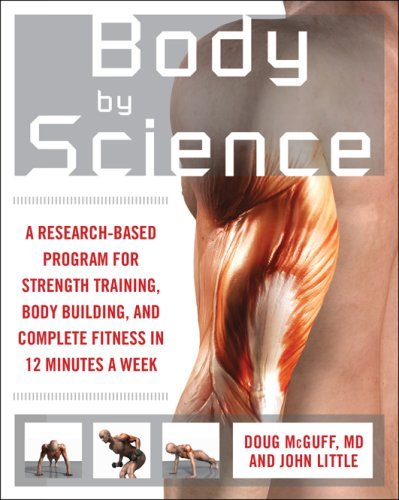Apr 12th, 2012 : by MAS.
In my last post Fat Loss and the Case For Less Exercise, I explained how I’ve designed my exercise plan to be as minimal as possible to maximize my chances at fat loss without increasing my appetite or risk of injury.
On the surface it appears the primary mechanism for fat loss is not burning calories, but increasing muscle gain. Increasing muscle increases metabolism which can result in greater fat loss. Up until I read Body By Science this is was the only fat loss pathway I was aware of when it came to resistance training.

Body by Science by Doug McGuff and John Little is by far the best book I’ve read on fitness.
http://www.youtube.com/watch?v=MzA-E8zb-Ds
http://www.youtube.com/watch?v=ToGt_GYCUmY
I’m going to list some of the fat loss ideas from Dr. McGuff’s book. I had to read this section three times before I felt I felt I understood it. If my understanding is flawed, please help me out in the comments below.
When I embraced High Intensity in late 2010, my volume of exercise dropped. Because my intensity increased, the result was precisely what Dr. McGuff said in the videos above, I got leaner. In my next post, I will conclude my thoughts on exercise and fat loss with an idea on where we should be directing our resources to maximize fat loss potential.
My HIT workout takes about 15 minutes, which includes light mobility work. The sprint session takes about 10 minutes, where most of the time is spent walking back to the bottom of the hill. The rowing takes less than 5 minutes. Adding everything together I am exercising less than one hour per week.To be clear, I am not saying this is the optimal plan for everyone. This is what has worked best for me. When I increase my exercise volume, I also increase appetite and risk of injury. I covered this in detail in the post How Exercise Indirectly Kept Me Fatter.
On the surface it appears the primary mechanism for fat loss is not burning calories, but increasing muscle gain. Increasing muscle increases metabolism which can result in greater fat loss. Up until I read Body By Science this is was the only fat loss pathway I was aware of when it came to resistance training.

Body by Science by Doug McGuff and John Little is by far the best book I’ve read on fitness.
Forget The Fat Burning Zone, Embrace High Intensity
The Cult of the Cardio loves to preach that exercising in a range between 60% and 70% of maximum heart rate maximizes fat loss. They call this range the Fat Burning Zone. When we lower our intensity into this range, not only can we exercise longer, but we access fat at a higher percent. Is this a good thing? Body By Science makes the case that it isn’t. Fat loss is not just about calories, it is also about hormones. Watch the two videos below (13 minutes in total) for a primer on High Intensity exercise and fat loss.http://www.youtube.com/watch?v=MzA-E8zb-Ds
http://www.youtube.com/watch?v=ToGt_GYCUmY
I’m going to list some of the fat loss ideas from Dr. McGuff’s book. I had to read this section three times before I felt I felt I understood it. If my understanding is flawed, please help me out in the comments below.
- The greatest metabolic effect comes when all muscle fibers are recruited.
- When we aren’t accessing body fat directly, we get our energy from glycogen stores. Glycogen provides “on-site” energy to the muscular system.
- Fast twitch muscle fibers have the most glycogen stores.
- Cardio does not tap the fast twitch muscle fibers. High intensity does.
- Because cardio does not meaningfully empty glycogen stores, circulating glucose in the blood must be stored as fat. The muscle cell walls lose their sensitivity to insulin. High intensity exercise causes the opposite to happen.
- Glycogen storage can diminish over time when we do not engage in exercise at high enough level. When those glycogen stores stay full, excess glucose goes to fat storage. This can lead to both muscle atrophy and insulin resistance.
- High Intensity Exercise activates hormone-sensitive lipase. Low Intensity doesn’t. Lipase permits the mobilization of body fat.
- Cardio produces more oxidative free radicals and inflammation than High Intensity.
When I embraced High Intensity in late 2010, my volume of exercise dropped. Because my intensity increased, the result was precisely what Dr. McGuff said in the videos above, I got leaner. In my next post, I will conclude my thoughts on exercise and fat loss with an idea on where we should be directing our resources to maximize fat loss potential.